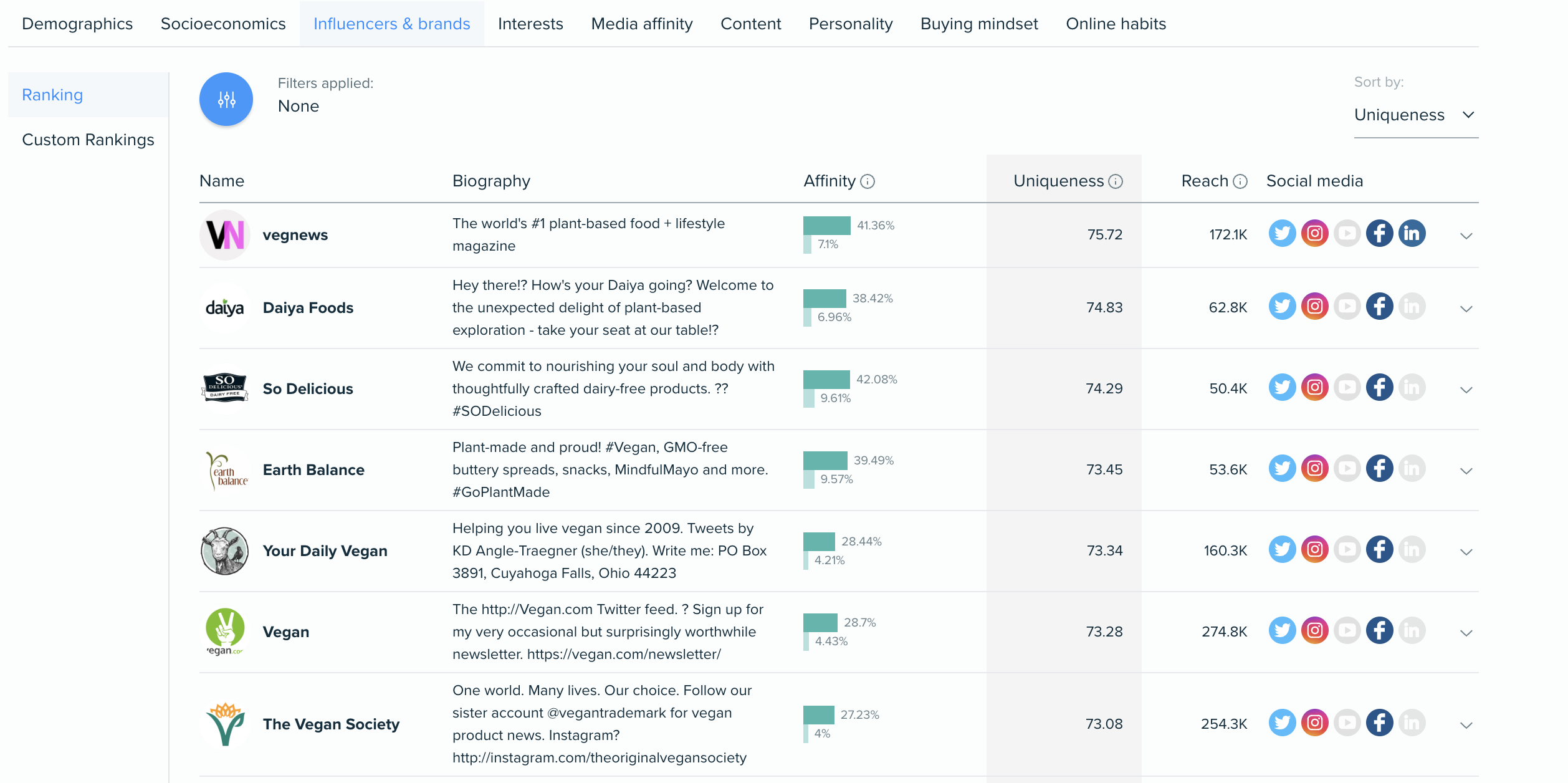When you visit the Influencers & Brands tab in your Insights reports, you'll find options to sort accounts by "Affinity" or "Uniqueness" (the default view). Here’s what these terms mean:
Affinity:
Affinity is a proprietary metric that helps you understand how much interest your audience has in a person, brand, or organization. It identifies the influencers most followed by your audience.
How is it calculated?
Affinity is inferred from audience interactions on X, such follows. A key component is the follower graph, which reveals how people are interconnected, helping us better understand their affinities.
When sorting by affinity, you’ll see the accounts that your audience is most interested in. For example, if 42.41% of your audience has an affinity for Elon Musk (compared to 4.57% of a global baseline), he will appear highly ranked. To find more relevant accounts for your audience compared to a baseline, you may want to sort by "Uniqueness."
Why doesn't the Affinity score add up to 100%?
Affinity percentages may not total 100% due to protected or suspended accounts, which are excluded from the analysis. Additionally, if multiple accounts are involved, and they have different follower counts, percentages can skew toward the larger account, especially if the sample size exceeds 250k.
In summary, affinity percentages often don't add up to 100% because of these factors, including sample size limitations and excluded accounts.

Uniqueness:
Uniqueness is a proprietary index that determines how relevant and unique a person or brand is to a specific audience or cluster. This index considers how "mainstream" an account is within the public (baseline) and penalizes those that are influential across the entire population, highlighting those especially relevant to your target audience.
How is it calculated?
The Uniqueness index ranges from 0 to 100, with 100 being the highest unique affinity. For instance, in a segment of vegans, our index might highlight influencers like VegNews and Daiya Foods over more mainstream brands like So Delicious, which are more popular with the general population.

Uniqueness Score Formula:
The formula for uniqueness considers both the popularity of the influencer within the target audience and the baseline audience. It favors influencers who are less known in the baseline but popular within the specific cluster.
The goal is to surface influencers that are truly niche within the cluster and down-rank those that are generally popular, like Obama or Lady Gaga. The formula also squares the affinity percentage of the cluster, further emphasizing the most influential and unique influencers.
For example:
= 100 * (200 + SEGMENT_AFFINITY - 2*B) / 300 = (200 + SEGMENT_AFFINITY - 2*B) / 3
If SEGMENT_AFFINITY is < 5%:
SEGMENT_AFFINITY - MULTIPLIER * BASELINE_AFFINITY
(SEGMENT_AFFINITY - MULTIPLIER * BASELINE_AFFINITY) / 10
B = BASELINE_AFFINITY: % of users from the baseline audience that has an affinity with the influencer
Check this Excel sheet where we've applied a simplified version of the formula (when you click on each in Column M, you will see the formula displayed in the top cell).
It also provides an easy explanation of why these influencers are relevant to that audience, using a ratio comparison against the baseline (X more likely).
How to Use the Uniqueness Score:
When you filter by Uniqueness in the Influencers & Brands tab, you’ll see the uniqueness score, which differs from the "Very Low/Low/High/Very High Uniqueness" metrics also available in the sorting menu. These metrics are relative to the selected baseline and are calculated differently.
Best Practice Tips for Score Selection:
-
Use Affinity to target the broader interests of your audience.
-
Use Uniqueness to reach your audience in a niche way that stands out.
For Baseline Selection with Uniqueness:
-
Baseline against the Full Audience to identify what makes a specific cluster unique compared to the "average member" of that audience.
-
Baseline against a specific country to see what differentiates a cluster from the "average citizen" of that area.
-
Baseline against the Global audience to understand what sets a cluster apart from "the average person."
Another way to think of affinity or uniqueness:
.png?width=688&height=258&name=image%20(93).png)
Related articles:
- FAQ: How does Audiense categorize influencers by Affinity, and how do they fall within the categories?
- Influencers & Brands Tab of Insights Reports